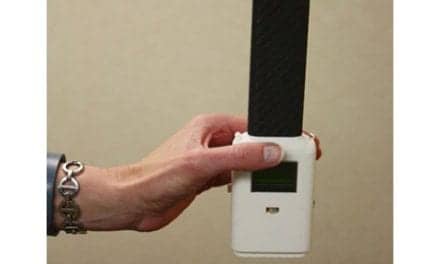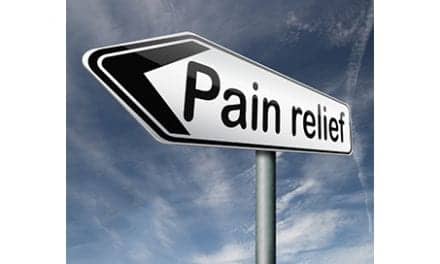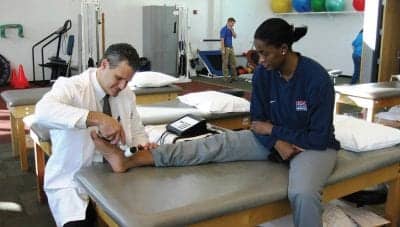
Brian F. Hagen, DPT, MS, OCS, FAAOMPT, applies a cold laser treatment to all-star WNBA player Swin Cash, of the Seattle Storm.
With youth sports players pushing their limits beyond the max and weekend warriors out in force, overuse injuries are rampant. Used as an adjunct to manual therapy in the war against pain, an array of modalities often provide some relief.
“We are seeing a lot more overuse injuries in the younger athletes. It’s really become sort of a national epidemic,” says Brian F. Hagen, DPT, MS, OCS, FAAOMPT, a sports medicine physical therapist who works with athletes and other patients. “People are playing at a different level than they did 20 years ago, or even 10 years ago, really.” Hagen serves as vice president, Network Services, Centers for Rehab Services/University of Pittsburgh Medical Center (UPMC), and program administrator-UPMC Center for Sports Medicine, and is a clinical assistant professor.
Amateur and professional athletes of all ages who play a variety of sports visit the UPMC Center for Sports Medicine after injury. The common thread among them is overuse injuries.
Physical therapists at the facility use modalities as a bridge, trying to return the patient to a phase of active movement and progressive strengthening, reconditioning, and functional training. “So that we can expedite the patient’s return back to their activities,” Hagen says. “Often, modalities are used early on for pain management and to help restore motion.”
Cold therapy (cryotherapy) is used to help reduce inflammation through vasoconstriction, which slows the inflammatory process, Hagen says. The spray and stretch technique can quickly alleviate acute pain and restricted range of motion due to muscle trigger points. The application of a vapocoolant acts as a counterirritant to myofascial pain due to muscle spasm and trigger points. Modalities often provide an analgesic or numbing effect early in the injury phase. Heat is also used to promote tissue elasticity and increase blood flow. Hagen says diathermy, a high-frequency electric current used for deep heating of tissues, is regaining visibility in the marketplace, as are electromagnetic types of heating. Electrical stimulation is used in two modes—pain control and muscle reeducation. For pain control, electrical stimulation actually acts as a counterirritant blocking transmission of pain impulses. For muscle reeducation—if an individual is having difficulty performing volitional contractions—the therapist can help strengthen the muscle by using higher-intensity electrical stimulation. For a postoperative patient, electrical stimulation may be used early on for pain control and later for muscle reeducation and strengthening, Hagen says.
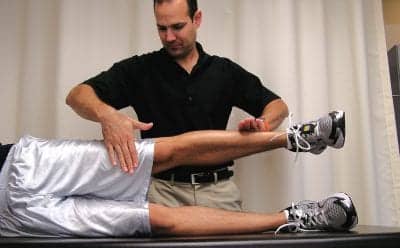
Erik P. Meira, PT, SCS, CSCS, performing manual stabilization exercise on a hip patient.
The Center also uses a cold laser for pain management. The modality often is applied more for overuse injuries than postsurgical. Medical literature reports the use of low level light therapy (LLLT) to treat acute and chronic neck pain,1 and one study offers an investigation of LLLT to treat lateral elbow tendinopathy (LET). The study found LLLT offered short-term pain relief as a safe, effective alternative to corticosteroid injections and NSAIDS.2 Clinical effects of LLLT in wound healing were spotlighted in another study that explored the mechanisms of LLLT, and found the modality’s ability to enhance tissue oxygenation and nutrition also works to improve non-healing wounds or slow-to-heal wounds in soft tissues, tendons, and bone.3 “We have a little bit to learn about exactly what it does and how it is best applied, but there does seem to be some promising potential for the utilization of cold lasers and light therapy,” Hagen observes.
Administering iontophoresis can be useful for pain control resulting from tendonitis, bursitis, and other inflammatory issues, Hagen says.
Biofeedback has proven effective for use with athletes in helping extinguish muscle spasms, and reeducation. “For example, if someone is having a hard time relaxing a muscle due to spasm or increased tone secondary to pain, inflammation, or postural problems, we can use biofeedback to help retrain them to relax the muscle.”
Hagen also notes he periodically reaches for topicals such as bio gels to help manage patients’ pain and help them feel better.
Patients who continue using pain modalities at home may speed their recovery. Physical therapists at UPMC’s Center for Sports Medicine often issue hot and cold packs or suggest patients obtain them from a local retailer. Electric stimulation units such as TENS or muscle stimulation units are issued for both muscle reeducation and pain control at home.
Many evidence-based, research-oriented physical therapy practices use modalities that are well regarded anecdotally, even though these devices and methods might not have a library’s worth of data to back them up.
“A lot of times, something will get out in the media and then the athletes demand to receive it,” says Erik P. Meira, PT, SCS, CSCS, of Black Diamond Physical Therapy, Portland, Ore. The practice treats many post-surgical and non-surgical cases for high school, collegiate, and professional athletes, and weekend warriors. “What they request may not always have a lot of science behind it. As sports medicine professionals, we still have to be proficient in some of these more trendy types of treatments, to stay on top of them to provide a service to our athletes—otherwise they’ll try to go elsewhere,” he says.
Meira often relies on modalities during sports events. He frequently uses elastic therapeutic taping as a stopgap measure to keep an athlete in the game. “You use elastic tape to cue the person to hold their shoulder in a better position so they don’t get an impingement-type syndrome or impingement-type pain. Then you can get them out there; they can play through their sport. But the second you take the tape off, it’s done, it hasn’t translated into anything.” It is believed that tension placed on the taped areas—with strong tape and strong adhesive—changes the athlete’s joint position, he says. The taped, injured area is supported and has time to recover.
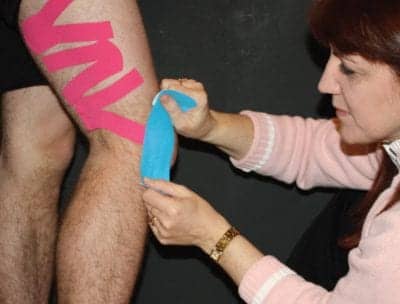
Graceann G. Forrester, PT, DPT, CKTI, using elastic therapeutic taping techniques. Fascia correction (red) is designed to increase fascia mobility and glide of the iliotibial band, and mechanical correction (blue), to limit lateral tracking of the patella while maintaining normal motion at the knee.
At halftime Meira will relieve an injured athlete’s acute pain with ice and electric stimulation for 15 minutes. “If they have a sprained ankle or something like that that’s really sensitive, we may be able to get it to calm down with ice and e-stim and send them back out on the field or the court, after screening to be sure that the injury is minor and they’re not at risk of further injury,” he says, musing that sometimes the placebo effect might be at work. “They get the sense that it’s being treated and they feel more confident, and they go back out there and do better.”
Operating on the gate pain theory, therapists at Black Diamond also use electrical stimulation concurrently with ice to help mask acute pain after surgery. “The pain is perceived by an electrical system basically, simplified as the nervous system,” Meira says. “We’re really aggressive with using ice and e-stim to try to calm it down. We override that sensation of pain with a different sensation from the electrical stim.” He finds this modality most useful in the first 2 weeks post-op or after an acute injury.
Graceann G. Forrester, PT, DPT, CKTI, works as a contract therapist with short- and long-term rehab facilities, and specializes in using therapeutic taping to help return injured athletes to play. She explains tape placed on the skin provides localized recoil or compression. “When you tape with rigid tapes, you compress tissue. This is often therapeutic and very comforting when something has felt sprained, or when the joint is lax,” Forrester says. “Compression stimulates the mechanoreceptors in the skin and even deep into the retinaculum of the joint. With elastic tape, the influence is a bit more subtle. You can target multiple tissues a little bit better.”
For a one-time taping, white athletic tape and brown rigid tape are successful in reducing pain or changing movement; however, because they do not allow the skin to breathe, they may cause skin irritation. The latex-free elastic tape Forrester uses on patients can comfortably remain in place for 3 days to 5 days.
In an acute scenario, rigid white athletic tape or brown and white combination tapes help to limit motion—both normal and pathologic—to allow the limb to rest, Forrester says. Elastic tape, which offers recoil, helps tissue to decompress, and can be used in the acute phase to aid in edema management and improved fluid dynamics. “With the elastic tape I use, I could reduce the impact of the compressed tissue of a hematoma so that particular phase of recovery is shorter,” she says. “We need to decompress the tissues so they remodel and line up well. This allows interstitial fluids to flow in between them again.”
In the subacute and rehabilitative phases, taping decisions often involve patients’ biomechanics. Rigid taping may be used, but it usually limits normal as well as pathologic motions. Elastic tape can be used on different tissues, whether muscle, fascia, or lymphatic, as well as the joints specifically—to limit some pathologic movements but maintain normal range and aid in pain management.
While modalities do not replace exercise or manual therapy techniques, they can be a useful adjunct in the therapist’s arsenal of weapons to help extinguish pain.
Judy O’Rourke is a contributing writer for Rehab Management. For more information, contact .
REFERENCES
- Chow RT, Barnsley L. Systematic review of the literature of low-level laser therapy (LLLT) in the management of neck pain. Lasers Surg Med. 2005 Jul;37(1):46-52.
- Bjordal J, Couppé C, Ljunggren A. Low level laser therapy for tendinopathy: evidence of a dose-response pattern. Physical Therapy Reviews. 2001;6(2):91–99.
- Phototherapy — a treatment modality for wound healing and pain relief. Hawkins D, Abrahamse H. African Journal of Biomedical Research, Vol. 10 (2007); 99 – 109.


